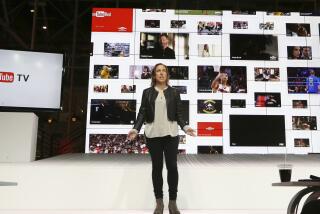YouTube counting on former Netflix exec to help it turn a profit
Google Inc.’s YouTube was counting on Hollywood’s love affair with sequels when it hired Robert Kyncl as its emissary to the studios.
As a key architect of Netflix’s popular on-demand Internet streaming service, Kyncl negotiated the deals that gave subscribers access to thousands of movies and television shows. Now he’s hoping to repeat that feat as head of TV and film for Google and YouTube, the world’s largest video platform, with 500 million monthly viewers.
Kyncl is working to broaden the site’s entertainment offerings beyond what YouTube is best known for — countless music videos, first-person accounts of natural disasters and quirky user-created productions like the recent marriage proposal shown as a trailer before the movie “Fast Five.”
The 40-year-old executive is helping bring order to the chaos that is YouTube, which receives a staggering 48 hours of new footage uploaded every minute. He is talking to production companies about organizing videos into “sets” or collections of themed content, akin to television channels. Meanwhile, YouTube’s engineers are working to improve recommendations to help viewers figure out what to watch in this universe of infinite choices.
“The more the videos are relevant to you, the more you will be immersed in that experience, the more time you spend with us — which is precisely the goal,” said Kyncl, who joined YouTube in September.
For now, people spend about 15 minutes a day watching YouTube videos on their computers, mobile phones and tablets. But Kyncl and other YouTube executives are preparing for the time when Internet-connected TVs become mainstream and the service can vie for a piece of the five hours a day people spend watching network and cable programs in their living rooms.
YouTube’s challenge is to overcome its image as short-attention-span theater: a place to come for quick bursts of entertainment such as sketch comedy group Smosh, squeaky-voiced “Fred Figglehorn,” or gamer enthusiasts’ channel Machinima.
“They know they have this massive audience,” said Paul Verna, senior analyst for research firm EMarketer Inc. “But they also know when people think about watching a long-form movie or a TV show, they’re not going to YouTube.”
YouTube, which is still losing money, needs to secure the kind of long-form content that plays well on big-screen TVs as part of a broader plan to push it into the black. The site is expanding its reach geographically and onto an increasing number of devices, as well as finding new ways to support existing creators while identifying new ones who can bring millions of viewers to the platform.
As Google seeks to monetize the online video site for which it paid $1.65 billion to acquire in 2006, it is constantly refining its approach to advertising, including a decision to charge only when viewers watch the promotions. These efforts are paying dividends. Although Google does not break out YouTube’s finances, Citi Investment Research estimates the site’s revenue reached $825 million in 2010, and is on its way to crossing the $1-billion mark this year. Google has said that it expects YouTube to turn a profit in the not-too-distant future.
YouTube’s content strategy is a stool built on three legs: user-created content, Web original programming and movies and TV shows. Kyncl was recruited to work his entertainment connections. His resume shows that the Czech-born executive is capable of conducting shuttle diplomacy between the sometimes warring cultures of Hollywood and Silicon Valley.
Like many, Kyncl got his start in the mailroom of a talent agency. He did a stint for a fund that co-financed studio films and later negotiated global distribution deals for Time Warner Inc.’s HBO. When dot-com mania gripped the Bay Area, Kyncl took a job with a technology start-up that built an online virtual world for children.
He made his mark when he joined Netflix Inc., the Silicon Valley firm that would revolutionize movie distribution. He oversaw the creation of its Internet video delivery system and worked to assuage the fears of studio executives, who worried that online delivery would fan piracy.
The biggest breakthrough came when Netflix figured out a business proposition that would entice Hollywood to unlock its movie vault and break the content logjam: a $1-billion deal with pay-TV channel Epix for online rights to films from Paramount, Lionsgate and Metro-Goldwyn-Mayer that Kyncl helped negotiate last August.
“My experience with him is that he is sensitive to all of the various concerns and issues … from a studio perspective,” said Curt Marvis, digital media president at Lionsgate.
In his eight-month tenure at YouTube, Kyncl and his team have done what his predecessors failed to accomplish: reaching deals with Warner Bros., Universal and Sony Pictures that added 3,000 movie titles to the site’s on-demand rental service.
“We’ve had many very interesting conversations with YouTube about things we could do,” said Thomas Gewecke, president of Warner Bros. Digital Distribution. “Robert was able to bring those conversations to specific closure.”
Entertainment executives said Kyncl not only understands the studios’ business, but he also has been receptive to suggestions about creating a store that segregates the paid content from the freely available, user-generated videos.
“Robert’s come in with a refreshing approach, saying, first off, ‘Content creators, how do you want to work with YouTube?’” said Zander Lurie, CBS Corp.’s senior vice president of strategic development.
Kyncl isn’t just courting the major studios. He also is in talks with digital production companies including Ashton Kutcher’s Katalyst to create themed channels that combine original online content with a curated selection of amateur videos.
“There’s so much posted there [on YouTube], what happens is you end up with these popularity cul de sacs,” said Katalyst President Anthony Batt. “What Google/YouTube has to add, and what people really need, are strong, opinionated programmers saying … this is an organized collection of content that is really meaningful.”
Kyncl’s goal is to leverage YouTube’s unparalleled global reach by creating programming that can’t be found on cable or satellite TV. The site can target unaddressed niches — such as its Threadbanger channel for do-it-yourself fashionistas — because of its ability to amass an audience around genres too narrow for traditional TV, he said.
“There is a Food Network on TV, but there are plenty of vegans around the world who would be incredibly interested in video content around that,” Kyncl said. “So, think about us as a complement to what happens in the traditional space.”
More to Read
Inside the business of entertainment
The Wide Shot brings you news, analysis and insights on everything from streaming wars to production — and what it all means for the future.
You may occasionally receive promotional content from the Los Angeles Times.










